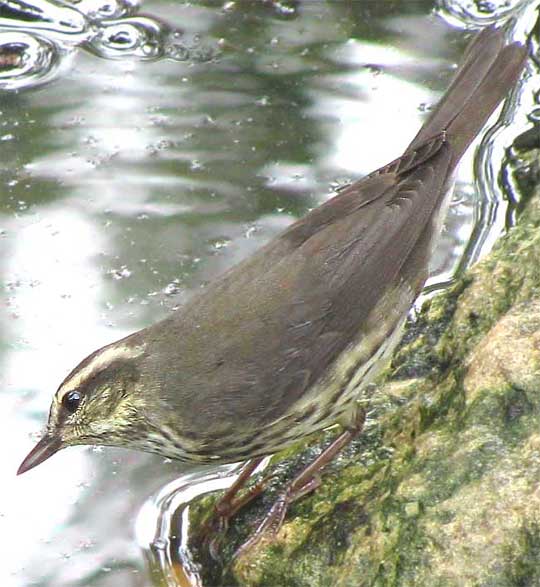Excerpts from Jim Conrad's
Naturalist Newsletter
from the October 13, 2008 Newsletter written in Yokdzonot and issued from a ciber in Pisté, Yucatán, MÉXICO
A TAIL-BOBBING WATERTHRUSH
A couple of Newsletters ago I told you about the Summer Tanager just arrived from North America, to overwinter here, who was much less nervous about being around people than the permanent birds. Last weekend I heard a familiar bright, metallic TCHINK, TCHINK, TCHINKING right outside my casita door in Sabacché and I figured I had another recent arrival. Sure enough, not ten feet from the door a Northern Waterthrush foraged along the edge of the cesspool that collects my bathroom waste and generates mosquitoes, shown below:

Both Northern and Louisiana Waterthrushes visit the Yucatán, the Northern staying all winter but the Louisiana only passing through between nesting grounds to the north and a winter home farther south. The two species look a lot alike. The Louisiana's eye stripe, or supercilium, is white, while the Northern's ranges from pale yellow to whitish. In the shade it was hard to tell whether this bird's supercilium was white or whitish. Other differences are that the Louisiana's bill is relatively larger, and the bird has a white throat, while the Northern's throat is spotted. It wasn't until I could study my pictures that I was sure I had a Northern. Louisianas prefer running water while Northerns hang around swamps, lake and river margins, so that also hinted at it being a Northern.
Waterthrushes bob their rear ends in a very exaggerated fashion. They almost seem to be parodying what a tail-bobbing bird could be like. You can't watch a waterthrush bobbing its tail without thinking that for a bird to put so much energy into moving that rear end up and down it must be vitally important for the species' survival. Other unrelated species such as Spotted Sandpipers and Palm Warblers also wag their tails, so the behavior must have arisen spontaneously several times during bird evolution, and been important enough to have been retained. However, the vast majority of birds get along just fine without tail-bobbing, so this is another of those evolutionary head-scratchers.
It's assumed that tail-bobbing distracts a predator's attention from the head, so the potential prey is more likely to escape.